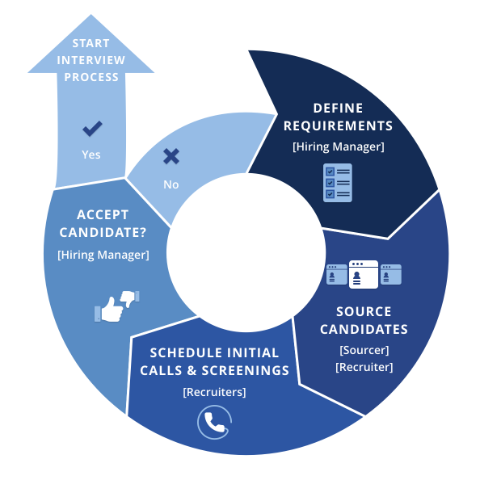When it comes to the recruiting process – it’s pretty much the same everywhere, right? We define a new role, interview some people and make a hire – it’s all very similar. But, when you start to optimise your recruiting process and you learn to tweak it based on your learnings, well that’s where the magic happens.
Recruitment is a service and our aim should always be on getting a bit better every day. Hires should be of higher quality, candidate and hiring manager experience should be improved and our process should become more and more efficient.
This mentality is a big one in Agile and Lean project management, and one which we should be instilling in our team and our recruitment projects. In order for us to become better recruiters, we need to constantly learn from our successes and failures. Only when we are aware of what works and what doesn’t – and why – can we refine our methods and practices. And that’s when ‘a bit better every day’ happens.
At LevelUp, we’ve started implementing Agile recruitment to make sure we are learning and optimising our projects constantly. We’re not fully agile just yet, but we have already started using some key aspects. We iterate the process frequently, work in 2-week sprints and review our progress in “retrobreakfasts”. Using Lean principles, we’re also making sure unnecessary (wasteful) aspects are removed as much as possible.

On a personal note, I love (and I am mildly obsessed with) processes – especially efficient ones! There’s just so much comfort in having a plan that works. And the satisfaction of getting to the end goal quicker, and with a better result than expected is the ultimate high (for me at least)!
In the past few years of creating, implementing and refining processes, I’ve established 4 rules of thumb you can use to make your recruitment operations smooth and productive.
1. Repeat key stages in your recruiting process so there is always a plan B
All recruiters know that the hire is the gold at the end of the rainbow. It’s what we all work towards, and what gives most of us that rush of excitement. With this in mind, we shouldn’t only focus on the end result. Common feedback from hiring managers include wanting a shorter time to fill, having more (qualified) candidates in the pipeline, and knowing there’s a safety net. A continuous flow of candidates can solve these needs.
You know that saying, “don’t keep all your eggs in one basket”? That’s very true for recruitment. We should never pin all our hopes and dreams on that one candidate. Let’s face it, you never know what could happen! He/She could accept another offer at the last minute, or the hiring managers might change their minds about the offer. Realising that recruitment is more of a cycle with key stages (sourcing, reaching out, phone screens and interviews) being repeated, will ensure the pipeline stays full and there’s always a backup plan.
2. “Think big, start small, move fast”
This is IBM’s AgileTA motto and I think it’s one of the phrases that resonate the most with me about recruitment process optimisation. It’s all about keeping the ball rolling and only doing the tasks which get us one step closer to the goal.
You may ask, “what impact do Agile principles have on recruitment?” Some of the benefits include:
- Constantly keeping the hiring managers engaged and involved in the process
- Maintain transparency and focus with small intervals of planned work
- Review progress often which helps in dealing with last-minute changes
- Self-organising teams are more proactive, and people take ownership for their actions
- There are collaboration and commitment to work together to achieve success
- Learning and development is continuous with regular reviews
If you’re interested in getting some more insight into IBM’s AgileTA, check out this blog post and look at the visual below which gives a high-level overview of a 2-week recruitment sprint from Beamery:

3. Focus on progress, not process
It’s quite common to spend a lot of time to develop a structure and to optimise your recruiting process first. But what happens when that structure is too rigid? In that case, progress stagnates. The aim of any process should be to have forward movement to the goal.
Think of it this way:
When you need to restock your fridge, the process might include identifying what you need to buy at the grocery store, going to the store and buying the food, and then packing the groceries away at home. But, without making space in your kitchen for the new food or actually going to the store, you won’t end up with a restocked fridge.
The process itself may be the backbone for achieving the goal. However, without progress, the end result will never be reached. And what’s the key to making progress? Well, that’s continuously improving the procedure, and learning from the successes and mistakes.
4. Make sure each and every action adds value
When adding a new task or action to the recruiting process, the first question should be: “Is this going to move us closer to our goal?” If the answer is “maybe”, hesitation, or a flat-out “no”, don’t do it! We should only be putting our time and effort into things that have a direct, positive impact on the process.
This is a key principle used in Lean Six Sigma project management. Eliminate as many wasteful activities so that there are only value-adding activities remaining.
Within recruitment, wasteful activities could be:
- Transportation: switching focus between tasks or roles often, or having unnecessary interview stages (e.g.: 3 face to face interviews, 1 tech assignment and lunch with the entire team)
- Waiting: for hiring managers to respond to questions via email, instead of just picking up the phone and getting a decision directly
- Overproduction: Over-filling the pipeline with high volumes of candidates sourced without knowing if these profiles are the best fit, or rewriting the job vacancy over and over to get it absolutely perfect
- Inventory: posting the job vacancy on numerous paid platforms which don’t target the right market
- Motion: holding multiple intake meetings with the hiring manager asking the same questions or putting in a lot of time to find additional info just for the sake of having additional info
To summarise, in order to optimise your recruiting process you need time and effort. It’s not going to happen overnight! But with these 4 ways to optimise your process, you can easily gain more speed and impact on recruitment. Using principles from Agile and Lean will help you to continuously enhance the operation. Take baby steps, focus on doing tasks that are beneficial and not wasteful and learn constantly.
Perhaps my biggest learning about how to optimise your recruiting process is that you’ve got to make it work for you! Be flexible enough to be able to change things around if necessary, focus on moving forward and commit to the progress

